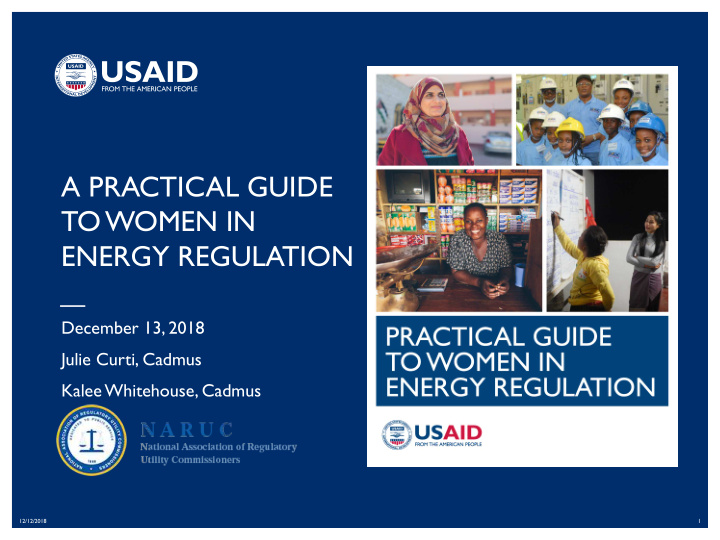



A PRACTICAL GUIDE TO WOMEN IN ENERGY REGULATION December 13, 2018 Julie Curti, Cadmus Kalee Whitehouse, Cadmus 12/12/2018 1
NARUC AGENDA • Overview of the Practical Guide to Women in Energy Regulation • Women’s Roles in Energy Regulation • Overview of Regulatory Policy Excerpt of the Guide 12/12/2018 2
OVERVIEW OF THE GUIDE • Introduction • Overview of Women in Energy Regulation • Topic Chapters – Employment – Energy Regulatory Policy – Energy Infrastructure • Framework of Strategies • Resources 12/12/2018 3
GENDER & ENERGY REGULATION WHY WOMEN MATTER IN ENERGY REGULATION Gender diverse workforces are good business practice. Gender equity improves economic prosperity for all citizens. Integrating women into the energy sector provides agency to women affected by energy decisions. Gender sensitive energy regulatory policies can improve policy outcomes for women. Improving gender equity in energy regulation helps to advance the UN Human Rights Principle of Gender Equality. 12/12/2018 4
ROLES OF WOMEN IN THE ENERGY SECTOR 12/12/2018 5
PRINCIPLES OF EFFECTIVE ENERGY REGULATION 12/12/2018 Source: Archer (2007) 6
INTERSECTION OF GENDER AND REGULATION 7 12/12/2018
Infrastructure Employment Regulatory Policy Lever • • Human Resources Policies • LEVERS FOR Partnerships ENERGY • • Procurement Policies REGULATORS • Tariff Setting • • Data Collection and Reliability • • Stakeholder Engagement and Mediation • • Licensing Requirements • • Monitoring and Evaluation 12/12/2018 8
GENDER EQUITY IN ENERGY REGULATORY POLICY 12/12/2018 9
BARRIERS: ENERGY REGULATORY POLICY Existing vulnerabilities due to limited energy access Limitations of influence on policy decisions Limitations of national level policy Lack of gender-disaggregated data 12/12/2018 10
Levers for Regulators: • Tariff setting ENERGY REGULATORY POLICY: • Data collection and reliability STRATEGIES Stakeholder engagement • mediation • Licensing requirements • Monitoring & Evaluation • Collect gender-disaggregated data , to understand policy and regulatory impacts • Provide tariff options and incentives that are informed by gender- disaggregated data • Link the energy sector to national policies and regulations by implementing national directives on gender equality within the energy value chain. 12/12/2018 11
AFRICA SPOTLIGHTS: ENERGY REGULATORY POLICY USAID 12/12/2018 Photo Source: MiDA 12
TANZANIA: GENDER POLICY IN STRATEGIC PLANNING Overview • The Energy and Water Utilities Regulatory Authority (EWURA)’s Strategic Plan of 2017- 2022 aims to create a framework for gender integration within the Authority Strategies for Implementation: • Monitoring effects of electric tariffs on women • Establishing a gender focal unit within the Authority • Gender reporting on stakeholder participation and working group attendance Intern in Tanzania Gains Skills in Natural Gas Monitoring: EWURA is a host of NARUC’s Women in Energy Regulation Pilot Program 12/12/2018 Photo Source: NARUC 13
GHANA: GENDER AND POWER SECTOR REFORM Overview • The Millennium Challenge Corporation and the Government of Ghana established the Ghana Power Compact which will incorporate gender into its planning for Ghana’s Energy Commission, and the Public Utilities Regulatory Commission (PURC). Activities within the PURC and Energy Commission: • Conducting a human resources comprehensive assessment and action plan development • Development of a new tariff review process to include more women • Updating data collection methods and indicators to include gender data and sensitivity 12/12/2018 14
ADDITIONAL TOPICS AND CASE STUDIES Source: Nam Theun 2 Power Company Source: ARESEP: Women’s Literacy Classes, Lao PDR Lao PDR: Strategies for Gender Costa Rica: Women’s Equity in Energy Infrastructure Employment in the Energy Sector 12/12/2018 15
NEXT STEPS • To decide which strategies are best for their commission, energy regulators can create a process of identifying their priorities, planning, and implementation. Several steps include: – Secure an executive commitment to achieving gender equality – Form a working group to collect data and consult with stakeholders to understand barriers and opportunities – Review findings and determine action steps to prioritize that fall within the commission’s authority – Monitor and evaluate progress , adjusting as needed where challenges are encountered 12/12/2018 16
T o access the full guide, please visit: www.naruc.org/international/where-we-work/global- initiatives/gender/ THANK YOU! Contacts: Bevan Flansburg (BFlansburg@naruc.org) 12/12/2018 17
APPENDIX 12/12/2018 18
DEFINITIONS Refers to the absence of discrimination, on the basis of a person’s sex, in the allocation of benefits or in access to services. Gender equality entails the concept that all human beings, both men and women, are free to develop their personal abilities and make choices without the limitations set by stereotypes, rigid gender Gender Equality roles, or prejudices. Gender equality means that the different behaviors, aspirations, and needs of women and men are considered, valued, and favored equally. It does not mean that women and men have to become the same, but that their rights, responsibilities, and opportunities will not depend on whether they are born male or female. Inequality, discrimination, and differential treatment on the basis of sex can be structural. Gender equity means fairness of treatment for women and men, according to their respective needs. This may include equal treatment or treatment that is different but considered equivalent in terms of rights, benefits, obligations, and opportunities. In the development context, a gender equity goal often requires Gender Equity built-in measures to compensate for the historical and social disadvantages of women. Specific measurements and monitoring are employed to ensure that, at a minimum, programs, policies, and projects implemented do not leave women worse off than men in their peer groups and families and that measures are taken to compensate for historical and social disadvantages. 12/12/2018 19
Recommend
More recommend